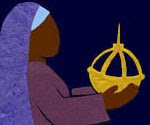1. The missionaries' apartment. We shared with the companionship who worked in the area just southeast of us.
2. The street in Gualey where a couple of members and an investigator lived. I arrived just after Espaillat had been broken off from the adjacent ward to become its own branch. That decision had been made based on our having about 200 members on the records; 11 adults were active on a weekly basis. But church leadership in the DR really wanted a temple, and multiplying units was the way to get it.
3. La Escuela / Liceo Republica de Colombia. A public elementary school where my companion and I went once a week to volunteer as assistants for one of the teachers. Probably the most meaningful community service (meaningful for me, anyway) I did during my time as a missionary.
4. The meetinghouse attended by our branch, as well as by the ward from whom we had been broken off. There was conflict between the (mostly American) missionaries and the local leadership, centered in the ward but spilling over into my branch as well. It reached a heady adrenaline-laced crisis when our (American) mission president demanded that the (Dominican) stake president put a stop to certain prayer meetings being held by the priesthood leaders in our ward and branch, which our mission president (and the missionaries) regarded as apostate. I feel very differently about this incident now than I did at the time; I should blog about it, maybe next month.
5. According to the church's online meetinghouse finder, there's now a meetinghouse here, though it wasn't there when I served.
This is fun: Searching for information about Ensanche Espaillat online, I quickly discovered the blog of a neighborhood organization, Amigos y Vecinos Ensanche Espaillat. It looks like they hold block parties and do raffles; they post announcements of residents' deaths and marriages. I found one post featuring photos of the "ausentes de Espaillat"--former residents sending greetings back from New Jersey or Florida. Thumbs up for civil society!
One post provided the following government statistics about Ensanche Espaillat: There are 4,000 dwellings in the neighborhood (not counting Gualey), and nearly 16,000 people living there! That figure blows my mind, to the point where I'm dubious--but Espaillat was a densely inhabited neighborhood, even 20 years ago. Unemployment is at a relatively low 7 percent. A little under 3,400 women in the neighborhood are reported as being "amas de casa" [homemakers]; the blogger juxtaposes that statistic with the fact that there are only 96 "empleadas domesticas" [domestic employees, female] to remark that "el barrio tiene verdaderas amas de casa" [the neighborhood has true homemakers]--which I take is meant as a commendation for the women who do their own cooking, cleaning, and washing instead of hiring someone to do it. Had this census been taken 20 years ago, the missionaries' maid would presumably have been one of those 96 empleadas domesticas. She would not have qualified, apparently, as a true homemaker even though she was actually running two households--ours, plus her own.
Other posts in this series:
9/30/1992 - La Milagrosa
8/12/1992 - A year after the call
7/1/1992 - FEDOPO
5/6/1992 - Guaricano
4/1/1992 - First day in Guaricano
2/5/1992 - The Zona Franca
12/4/1991 - La Romana
11/6/1991 - My first day in the Dominican Republic
10/9/1991 - Entered the MTC
9/4/1991 - Waiting to serve
8/1/1991 - Mission call



No comments:
Post a Comment